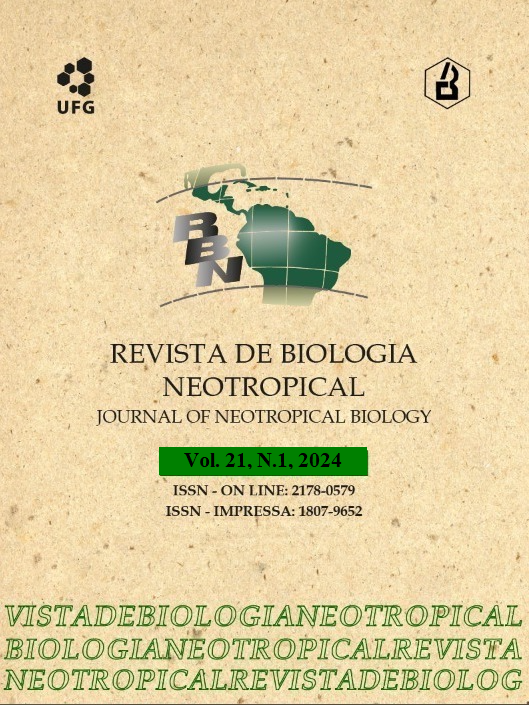First record of predation on Samea multiplicalis (Lepidoptera: Pyralidae) larvae by Furnariidae birdson salvinia plants (Salviniaceae)
Keywords:
Certhiaxis cinnamomeus, Furnarius figulus, foodAbstract
Certhiaxis cinnamomeus and Furnarius figulus are birds belonging to the Furnariidae family that occupy different habitats associated with the aquatic environment in all regions of Brazil. The diet of these birds consists mainly of invertebrate animals. Individuals of C. cinnamomeus and F. figulus were occasionally recorded foraging on Salvinia auriculata plants and preying on larvae of Samea multiplicalis, in the marginallagoons to the Rio das Mortes, Campos das Vertentes region, Minas Gerais,being the first report of this interaction.
Downloads
References
Coetzee, J.A. & M.P. Hill. 2020. Salvinia molesta D. Mitch. (Salviniaceae): impact and control. Perspectives in Agriculture, Veterinary Science, Nutrition and Natu-ral Resources, 15(33): 1-11. DOI: http://dx.doi.org/10.1079/PAVSNNR202015033
Crawley, M.J. 1989. The successes and failures of weed biocontrol using insects. Biocontrol News Info. 10: 213–223.
Diarra, B., K.J. Konan, L.M. Yapo & K.P. Kouassi. 2018. Aquatic macroinvertebrates associated with free-floating macrophytes in a marginal lentic ecosystem (Ono Lagoon, Côte d’ Ivoire). Journal of Entomology and Zoology Stud-ies, 6(3):1432-1441.
Driese, D.T. 1986. Factors affecting the establishment and survival of Anaitis efformata (Lepidoptera: Geome-tridae) introduced into Australia for the biological control of St. John’s wort, Hypericum perforatum. II. Field trials. J. Appl. Ecol. 23:821–839. DOI:https://doi.org/10.2307/2403937
Heredia, J., R.M. Jensen, C. Figuerero & J. La Grotteria. 2010. Cuatro Furnariidae ‘pescando’: Hornero (Furnarius rufus), Curutié Colorado (Certhiaxis cinnamomea), Remolinera Castaña (Cinclodes atacamensis) y Remolinera Chocolate (Cinclodes olrogi). Nuestras Aves, 55:17-19.
Julien, M.H. & M.W. Griffiths. 1998. Biological Control of Weeds. A World Catalogue of Agents and their Target Weeds. CABI Publishing, Wallingford, UK. 223p.
Lagos A.R., R.V. Marques, A.B. Moreno, K.V. Silva & M.A. Alves. 2005. Incubation and rearing-effort partitions of Wing-banded Hornero Furnarius figulus (Passeriformes: Furnariidae). Brazilian Journal of Biology, 65(2):281–286. DOI: https://doi.org/10.1590/S1519-69842005000200011
Lawton, J.H. 1990. Biological control of plants: a re-view of generalisations, rules and principles using in-sects as agents. pp. 3–17. In: Basset, C., L.J. Whitehouse & J.A. Zabkiewicz (Eds.), Alternatives to Chemical Controls of Weeds. FRI Bulletin 155, Rotorua, New Zealand.
Oliveira, G.C.S., L.G.T. Rubim & M.M. Souza. 2023. First record of Polybia scutellaris (White, 1841), (Hymenoptera: Vespidae) predating on Samea multiplicalis (Guenée, 1854) (Lepidoptera: Pyralidae), an herbivore of Salvinia spp. (Salviniaceae), Brazilian Journal of Biol-ogy, 83: e271130. DOI:https://doi.org/10.1590/1519-6984.271130
Oliveira, G.C.S. & M.M. Souza, 2023. New records of pre-dation of Samea multiplicalis (Guenée, 1854) (Lepidop-tera: Pyralidae) by social wasps (Hymenoptera: Vespidae) on Salvinia auriculata (Aublet, 1775) (Salviniales: Sal-viniaceae) in Brazil. Revista Chilena de Entomología, 9(3): 527-531. DOI:https://doi.org/10.35249/rche.49.3.23.11
Parys, K.A. & S.J. Johnson. 2012. Impact of the red im-ported fire ant, Solenopsis invicta (Hymenoptera: Formi-cidae), on biological control of Salvinia minima (Hy-dropteridales: Salviniaceae) by Cyrtobagous salviniae (Coleoptera: Curculionidae). The Florida Entomologist, 95(1): 136-142. DOI: http://dx.doi.org/10.1653/024.095.0121
Pelli, A., F.A.R. Barbosa & E. Taylor. 2008. Samea mul-tiplicalis (Guenée, 1854) (Lepidoptera, Pyralidae): a potential agent in the biological control of Salvinia molesta DS Mitchell (Salvineaceae). Acta Limnologica Brasiliensia, 20(2): 119-123.
Pratt, P.D., E.M. Coombs & B.A. Croft. 2003. Predation by phytoseiid mites on Tetranychus lintearius (Acari: Tetranychidae), an established weed biological control agent of gorse (Ulex europaeus). Biol. Control, 26: 40–47. DOI: https://doi.org/10.1016/S1049-9644(02)00114-7
Remsen, J.V. 2003. Family Furnariidae (ovenbirds). pp: 162– 357. In: del Hoyo, J., A. Elliott & D.A. Christie, eds. Handbook of the birds of the world. Vol. 8. Lynx, Barcelona.
Sick, H. 2001. Ornitologia brasileira. Rio de Janeiro, Ed. Nova Fronteira. 912 p.
Tipping, P.W., M. R. Martin, L. Bauer, R. M. Pierce & T. D. Center. 2012. Ecology of common salvinia, Salvinia minima Baker, in southern Florida. Aquatic bot., 102: 23-27. DOI: https://doi.org/10.1016/j.aquabot.2012.04.005
van Klinken, R.D., G. Fichera & H. Cordo. 2003. Target-ing biological control across diverse landscapes: the release, establishment, and early success of two insect on mesquite (Prosopis spp.) insects in Australian range-lands. Biol. Control, 26: 8–20.
DOI: https://doi.org/10.1016/S1049-9644(02)00107-X
Warfe, D.M. & L.A. Barmuta. 2004. Habitat structural complexity mediates the foraging success of multiple predator species. Oecologia, 141: 171–178.
DOI: https://doi.org/10.1007/s00442-004-1644-x
Yofukuji, K.Y., A.L.P. Cardozo, B.A. Quirino, M.H.F. Aleixo & R. Fugi. 2021. Macrophyte diversity alters in-vertebrate community and fish diet. Hydrobiologia, 848: 913-927.
Downloads
Published
How to Cite
Issue
Section
License
Copyright (c) 2024 Revista de Biologia Neotropical / Journal of Neotropical Biology

This work is licensed under a Creative Commons Attribution-NonCommercial 4.0 International License.
The expontaneos submmition of the manuscript automaticaly implies in the cession of all patrimonial rights for the Journal of Neotropical Bilogy (RBN) after publication. The autor allow the right of first publication of the article to the RBN, under Creative Commons Attribution 4.0 (CC BY-NC 4.0) Licence.
There are garanties for the authors to the authorial and moral rights, for each one of the articles published by RBN, with permissions:
1. The use of article and contents for the education and researches.
2. The use of the article and their contents, linking to the Article on the web site of the RBN, allowing the divulgation on:
- institutional closed web (intranet).
- open access repositories.
3. Preparation and divulgation of the other publication derived from the article and its content, if there is citation of the original publication by RBN.
4. Make printed copies in small quatinties for personal use.

















